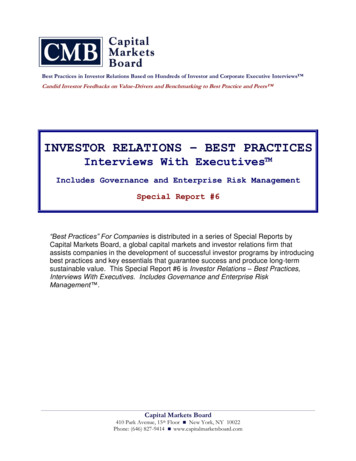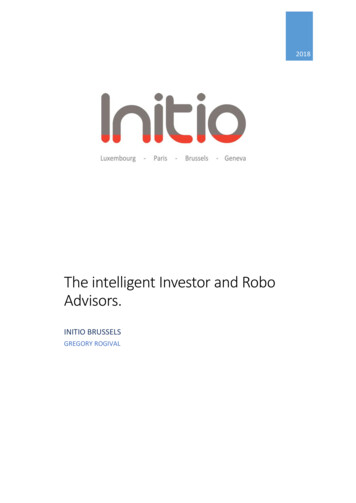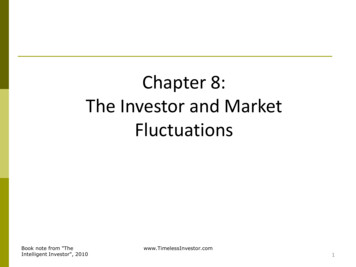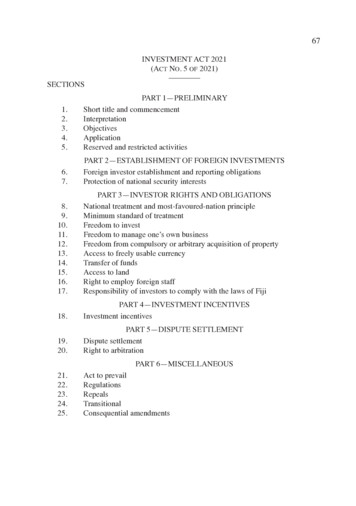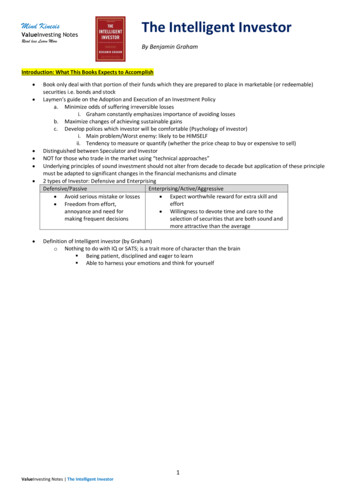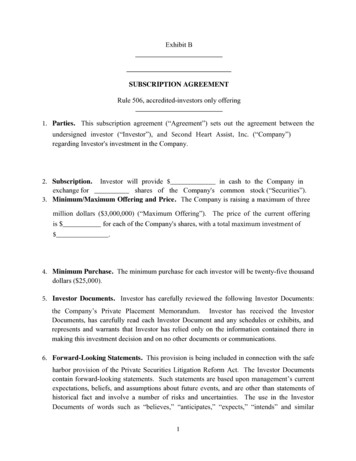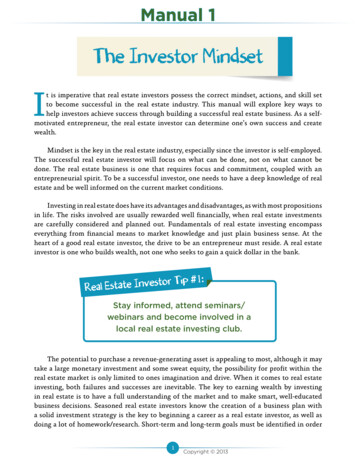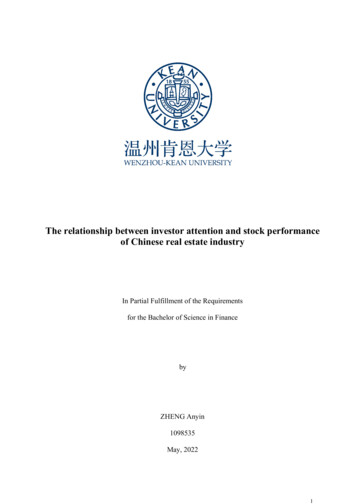
Transcription
The relationship between investor attention and stock performanceof Chinese real estate industryIn Partial Fulfillment of the Requirementsfor the Bachelor of Science in FinancebyZHENG Anyin1098535May, 20221
The relationship between investor attention and stock performanceof Chinese real estate industryDecember 1, 2021Anyin Zhenga,*aSchool of Accounting and Finance, College of Business and Public Management, Wenzhou-KeanUniversity, Wenzhou, China 325000.AbstractWith the development of the behavior finance and information technology, such as theemergence of Baidu index, provided a direct measure of investor attention. This study exploredthe relationship between investor attention and stock performance in the Chinese A-shared marketin real estate listed companies. We used a sample of 157 listed companies covering period from2016 to 2018 in China Stock Market and Accounting Research Database daily frequency. In thisstudy, the unit root test was used first to test data stability and then multivariate regression modelwas applied to examine the relationship. The result showed that the investor attention had asignificantly positive affect on firm’s stock performance. In terms of the robustness check, weused two methods to re-examine the relationship to reach a consistent conclusion. One was withalternative variable to change the measurement of investor attention; the other one was with thelag coefficient of the main variable to test the endogeneity. By monitoring the attention data of aparticular stock on the previous day, we could predict to a certain extent the change of stockdividend rate on the next day. The conclusion of this paper was helpful for investors to betterunderstand and predict the dividend rate of Chinese real estate market.JEL Classification: G41Keywords: Investor attention, stock performance, estate industry*Correspondence to Anyin Zheng at anyinz@kean.edu4
Introduction1.1 Background InformationThe traditional investment theory constructed a whole set of economic theory system on thebasis of rationality and market efficiency. However, with the development of financial market,traditional financial theory could not explain various irrational behaviors of individuals in theprocess of transaction. Therefore, behavioral finance began to emerge and gradually developedand improved, which played a supplementary role in explaining the traditional finance theory. Itsmain point of view was that investors were always affected by personal subjective emotions andother factors to varying degrees in the process of investment decision-making, which madeinvestors unable to make rational investment decisions. Investor attention theory combinedpsychology and behavioral finance to study the internal distribution mechanism and allocationefficiency of attention, which further improved the theory of traditional financial theory (Adra,2018).With the rapid development of Internet technology, the information people were exposedto also presents an exponential expansion, but people's ability to process information could notachieve rapid growth in a short period like computers. The average person could not cope with somuch information, and as Herbert Simon argued in his book Managing Behavior, it distractedattention and makes personal attention scarce. The contradiction between the excess ofinformation and the scarcity of attention restricts investors to a certain extent in analyzing andprocessing relevant information. Because of such constraints and limitations, investors had to beselective when processing information. Concentrating information resources on one thing alsomeant that cognitive attention was allocated from other things. The increase of investor attentionwould change the cognition degree of such assets, thus adjusting the investment portfolio, thusbreaking the dynamic equilibrium in the original trading market, and ultimately affecting thechange of asset price. Therefore, in the financial market, when investors made relevant investmentdecisions in the face of excessive information, it was actually a process of rational allocation of5
their own attention.As an important part of supporting the development of national economy, the real estateindustry had the characteristics of high price and high demand, which made people pay attentionto the real estate price. In the context of the Internet era, the operation mode of the real estatemarket had changed, and the prediction of real estate price had a new research direction andperspective (Ding, 2015). Behavioral finance was closer to real life than traditional economictheory, which assumed that the price of a product was determined by its value, based on the basicassumptions of rational man, utility maximization, and uniform preferences. In the current era, theability of investors to obtain information has been greatly improved, and many behavioral factorsof investors have been recorded in internet-related data, which could express the psychologicalchanges and attention fluctuations of investors, and may greatly affect the development of the realestate industry (Lou, 2014).1.2 Issue or research questionThe real estate industry was an important part of the national economy, and what factorseffected the real estate companies’ stock performance was a hot topic for the public at home andabroad. Whether the government, real estate companies or ordinary investors, were veryconcerned about the change of real estate stock prices. The real estate stock market was affectedby a variety of factors, including macroeconomic environment, upstream and downstream industrydynamics and relevant policy changes. In addition to these factors that were often considered, inthe real estate market, because the buyers and sellers were in an information inequality position,the buyers would try their best to search for more relevant information to assist decision-makingin order to reduce the possible damage caused by the information inequality. And the seller wouldknow more about the buyer in order to maintain its advantageous position. This made investorattention has become one of the factors that can’t be ignored. So what’s the specific relationshipbetween investors' attention and the performance of China's real estate stock market?6
1.3 Main findingsTo test our assumption, using sample data of Chinese real estate stock market from January1, 2016 to December 31, 2018 in China Stock Market and Accounting Research database toconstruct panel data set in daily frequency, and used Baidu index to construct quantitative proxyvariables of investor attention. In table 2, we found that there was a positive correlation betweeninvestor attention dividend rate of Chinese real estate companies. Through the unit root test intable 3, we found that the data were stationary series, and then we carried out multiple regressionwhich found the investor attention had a significantly positive effect on dividend rate of Chinesereal estate companies.To check the results, we performed robustness tests in two ways. First of all, in order tosolve the sample selection bias, we replaced the measurement method of proxy variables, and usedGoogle Trend instead of Baidu index to construct investor attention, so as to measure investorattention more comprehensively. As could be seen from Table 6, after regression calculation usingGoogle trend to replace Baidu index, investor attention still had a significant positive impact onstock returns. This finding had certain application value for individual investors. By monitoringthe attention data of a particular stock on the previous day, they could predict to a certain extentthe change of stock dividend rate on the next day.The regression results of current periods of investor attention all indicated that investors'attention can lead to the amplification of stock trading volume and turnover rate in the near future.However, for the current investor concern and the stock market performance, whether the investorconcern caused the change of the market performance, or the market performance caused theinvestor attention, can’t be well distinguished. Secondly, considering the influence of endogeneityon the significance of multiple regression results, we tested the original independent variableBaidu index with a lag of one period. As could be seen from Table 7, the lag coefficient of theoverall attention measure was still significantly positive at the significant level of 5%, which7
meant that the increase of attention one day in advance would significantly improve the predictionof future yield level.1.4 Contributions to investor, policy maker and literatureOn the one hand, for investors, the scarcity of attention raised the question of how to allocatethe limited attention among the many potential investments. The research and development ofinvestor attention could have a deeper understanding of human behavior and guide investors tomake investment decisions. At the same time, it was helpful to improve the relevant system ofinvestor protection, protected the interests of investors, and provided reference for other capitalmarkets in transition. On the other hand, for government regulation and control, mastering thecorrelation between investor attention and stock performance of companies related to Chinese realestate industry could more accurately control the operation state of the macro economy andprevent the occurrence of financial crisis, which played a crucial role in Chinese A-share market.Investor attention was an new emerging field of the academic study in finance. Comparedwith previous literature, the contribution and innovation of this paper were as follows: First,Investor attention was an new emerging field of study in finance the variable of investor attentionwas introduced in this paper, which could more accurately measure the relationship betweeninvestor attention and the return rate of Chinese real estate stocks in quantitative methods. Second,based on the advantages of daily data of Baidu Index, this paper confirmed that investor attentioncould positively affect the performance of the stock market. Third, because there were fewliterature about the combination of investor attention and Chinese real estate stock market in theacademic world, this paper could broaden the horizon of relevant academic researches and studies.This paper discussed its importance in China real estate industry from a new perspective ofinvestor attention, in order to establish a descriptive quantitative model that could accuratelyreflect the actual decision-making behavior of market subjects and the stock performance of realestate companies.8
1.5 The structure overview of this paperThe remainder of the paper proceeded as follows. Section 2 reviewed related literature anddevelops hypotheses. Section 3 described the method, sample, data and variable construction.Section 4 first explained the main result and then showed the robustness check for the result tokeep the consistent. Section 5 made the conclusion for the whole paper.2 Literature Review and Hypotheses Development2.1 The history about investor attention theoryLooking back at the history of financial research in recent decades, Markowitz (1952) foundedthe asset portfolio theory and opened up a new direction of financial research. Later, Sharpe (1964)discovered the relationship between expected return rate of assets and risky assets and proposedcapital asset pricing model, which became the theoretical basis of modern finance. Then, Rossproposed a model to describe the reasonable pricing of assets which called Arbitrage PricingTheory (APT), and Eugene F. Fama established and improved the efficient market hypothesis.Through the continuous efforts and improvement of numerous scholars, a modern financialtheoretical system with rigorous logic and unified content has been established on the basis of theabove theories, which has provided theoretical support for many financial academic researches.However, with the deepening of research, many scholars have found that there was a definitedifference between the content of financial theory and the reality, and some financial errors havebeen found in the study of the financial market. But traditional financial knowledge is difficult toeffectively explain these phenomena. At the same time, modern financial theory was based on theassumption of rational people, which was difficult to meet in reality. Based on this reason, somescholars began to combine psychology and finance theory to explain the operation of financialmarket from the perspective of investors behavior and psychological factors, thus formingbehavioral finance. Behavioral finance was the supplement and perfection of traditional economictheory, which was of great significance to the research and development of economics.9
Zhang (2011) studied the influence of Internet open source information on asset pricing andfound that Internet information has the ability to explain abnormal returns in China's stock market.The research of investor attention theory is a new field, one of the difficulties is how to quantifythe "attention". Peng and Xiong (2007) used stock trading volume to study investors' concerns andfound that market information and individual stock information compete for attention. Gao (2011)used Google Trends to quantify investor attention, and Song (2011) also used Google Trends dataas a proxy variable of investor attention to study IPO divergence in China's stock market.2.2 The Positive attitudes about investor attentionThe financial market was in dynamic change every day, and everyone's energy was limited.Individual investors could not accept all external information or pay attention to all stocks in themarket when they were faced with complicated related information. Aboody (2010) proposed thatstock price fluctuations were caused by the attention of individual investors, thus causing suchtemporary deviations. Quan and Wu (2010) believed that information paid attention to byinvestors would have an impact on stock price, while information not paid attention to by investorswould have no impact on stock price.Matthias Bank (2011), based on the statistical data of Google Trends, proposed that thestatistical data of Google Trends were positively correlated with the trading activity ofcorresponding stocks. Chen (2016) quantified investor attention by using Baidu index statisticsand search volume data of Shanghai Composite Index and Shenzhen Component Index. Theresults showed that the higher the attention, the higher the return on investment. Wang (2013) tookthe statistical data of Baidu search index as the research object and selected stocks according tothe industry classification standards of Shanghai Stock Exchange to conduct empirical analysis oninvestors' attention. Data showed that investor attention has positive effects on investment returnrate in different periods. Luo (2017) used Google trend search index and company market valueto replace investor attention and conducted multiple linear regression analysis on the stock market.10
The data showed that investor attention could cause fluctuations in securities trading. Mitchell(1994) found that there was a robust correlation between the number of daily news announcementsand stock trading volume of Dow Jones and market returns. Barber (2008) found that individualinvestors were net buyers of highly watched stocks. Andrei and Hasler (2014) found that investorattention was the main determinant of asset prices from both theoretical and empirical perspectives.Yu and Zhang (2012) tested the correlation between Baidu Index and gem stock marketperformance, and verified that investor limited attention can affect stock market trading activities.Based on the above discussions, investor attention was positively associated with stockperformance, we therefore proposed our first hypothesis.Hypothesis 1: Investor attention has a positive impact on stock performance in Chinese realestate industry2.3 The negative attitudes about investor attentionLiu (2014) took media attention as a proxy variable, built an econometric model andconducted a regression analysis on stock return rate and media attention, and found a negativecorrelation between them. Peng (2010) from the perspective of media attention, selected the newsquantity of each stock in the A-share market as A proxy variable for empirical research. The resultsshowed that the more media attention a company received, the lower the average return oninvestment on its stock. Rao (2009) found that the more attention media paid to listed companies,the lower the average stock return rate in the following month. Yang (2010) found that onlineattention had a positive impact on the daily return rate of stocks, but it turned into a negativeimpact on the next day. Drake (2012) confirmed that Google search can reflect investors' demandfor public information. Guo (2019) found positive and neutral news to PM2. 5 (fine particles)concept stock price had a significant positive impact, negative news on PM2. 5concept stocks hada significant negative impact.Based on the above discussions, investor attention was negatively associated with stock11
performance we therefore proposed our second hypothesis.Hypothesis 2: Investor attention has a negative impact on stock performance in Chinese realestate industry3 Data and methodologyThis paper studies the stock market performance of listed companies in Chinese real estateindustry by using econometric methods and Baidu index as a proxy variable for investor attention.Use, stock return rate, turnover rate, price earning ratio, trade volume and company current marketvalue to measure the market performance of the stock. The research of investor attention theorywas a new field, and one of the difficulties was that "attention" was difficult to measure. Thetraditional proxy variables of investor attention mainly included , media coverage and advertisingexpenditure. The emergence of Baidu index search provided an effective proxy variable forstudying investor attention. Compared with traditional proxy variables, it was more time-sensitiveand representative. Baidu index was an application based on search log analysis. It analyzedbillions of Baidu index results around the world to tell users how often a particular search termhas been searched over time and relevant statistics.In Baidu search, the trend chart of each keyword was divided into two parts: search volumeand news citation volume. Users could intuitively see the change trend of the search volume ofeach keyword in Baidu worldwide and the citation of related news, and detailed bar charts of cities,countries and regions and languages were displayed. Parameters related to stock marketperformance were derived from the China Stock Market Accounting Research database. Thisstudy selected Chinese real estate listed stocks as research samples in total. The period of stockdata was from January 1, 2016 to December 31, 2018, including stock turnover rate, price earningratio, dividend rate and the trading volume.3.1 Investor attention --- Baidu indexThis paper chose the weighted sum of users' search volume of a certain keyword in Baidu,12
namely the user attention of Baidu Index, as a proxy variable of investors' attention. Because Baiduis in a monopoly position in the domestic search engine market, using the Baidu index as the proxyvariable of investor attention had better representativeness and credibility. After the above analysis,this paper used the listed stock code to record the search volume data of Baidu index, and usedthe daily data of Baidu index as a proxy variable to measure investor attention, and defines asattentioni,t which represented the Baidu index of the i-th stock in phase t.3.2 Market trading indexThe dividend rate was a financial ratio that measures the value of the annual dividendrelative to the market value per share of a security. In other words, dividend rate formula calculatedthe percentage of the stock market price that a company payed out to shareholders in the form ofdividends. Return rate was the dividend per share divided by the market value per share. dividendper share was the company’s total annual dividend payment, divided by the total number of sharesoutstanding. Market value per share was the current share price of the company. This paperdefined the dividend rate as Reti,t.Turnover rate referred to the frequency of stock turnover in the market within a certainperiod of time, which was one of the indicators to reflect the strength of stock liquidity and wasmeasured as a percentage of the total number of shares traded during the year. Turnover rate wasthe volume over a period divided by total shares issued. The high turnover rate generally meantgood stock liquidity, easy access to the market, with strong liquidity. In this paper, the turnoverrate was define as turnoveri,t.The price-to-earning ratio was the ratio often used as an indicator to compare whetherstocks at different prices are overvalued or undervalued. Price-to-earning ratio was the share pricedivided by earnings per share. Under normal circumstances, the lower the price-to-earning ratioof a stock, the lower the profitability of the market price relative to the stock, indicating that theshorter the payback period, the smaller the investment risk, the greater the investment value of the13
stock. In this paper, the price-to-earning defined as the PEi,tThe price-to-earning ratio was the ratio often used as an indicator to compare whetherstocks at different prices are overvalued or undervalued. Price-to-earning ratio was the share pricedivided by earnings per share. Under normal circumstances, the lower the price-to-earning ratioof a stock, the lower the profitability of the market price relative to the stock, indicating that theshorter the payback period, the smaller the investment risk, the greater the investment value of thestock. In this paper, the price-to-earning defined as the PEi,tThe current market value was the approximate current resale value for a financialinstrument within finance. Just as with any other object of value, the current market value offersinterested parties a price for which they can enter into a transaction. The current market value wasusually taken as the closing price for listed securities or the bid price offered for over-the-countersecurities. This paper defined the current market value as MVi,tThe price-to-book ratio is used by company to compare a firm’s market capitalization toits book value. It was calculated by dividing the company’s stock price per share by its book valueper share. An asset's book value was equal to its carrying value on the balance sheet, andcompanies calculate it netting the asset against its accumulated depreciation. This paper definedthe price-book ratio as PBi,tThe price-to-cash flow ratio was a stock valuation indicator or multiple that measured thevalue of a stock price relative to its operating cash flow per share. The ratio used operating cashflow, which added back non-cash expenses such as depreciation and amortization to net income.This paper defined the price-to-cash flow ratio as PCFi,tThe price-to sales ratio was an investment valuation ratio that showed a company's marketcapitalization divided by the company's sales for the previous 12 months. It was a measure of thevalue investors were receiving from a company's stock by indicating how much they were payingfor the stock per dollar of the company's sales. This paper defined the price-to-sale ratio as PSi,t14
Since the relationship between multiple variables was involved in this study, the multiplelinear regression model was used for statistical analysis, and the equation was constructed asfollows:𝑅𝑒𝑡 ,& 𝛼 𝛽 𝑎𝑡𝑡𝑒𝑛𝑡𝑖𝑜𝑛 ,& 𝛽0 𝑃𝐸 ,& 𝛽3 𝑡𝑢𝑟𝑛𝑜𝑣𝑒𝑟 ,& 𝛽7 𝑀𝑉 ,& 𝛽: 𝑣𝑜𝑙 ,&(1) 𝛽 𝑃𝐵 ,& 𝛽? 𝑃𝐶𝐹 ,& 𝛽B 𝑃𝑆 ,& 𝜀 ,&4 Result and discussion4.1 Main resultThe multiple linear regression model included the control variables that were know to capturefuture yield, and after calculating the p-value, the variable attentioni,t and voli,t was statisticallysignificant at 1% level for the sample 3-year data. So it could be seen that there was a significantand positive relationship between the dependent variable dividend yield and the independentvariable investor attention. Therefore, we could say that the stock return rate and trading volumehad significantly positive relationship. On the other hand, after calculating the p-value of theturnover rate and the price-earnings ratio, we found that there was not significant relationshipbetween them and the dependent variable stock return rate. The regression results of panel datawere sorted out in Table 3. After controlling the turnover rate, price-earning ratio, price-book ratio,volume and other factors in the market, investor attention had a significant positive impact ondividend rate.In addition, we found that the result were not only statistically significant, but alsoeconomically significant. For example of the dividend rate in Table 3, the coefficient on theattentioni,t is 0.0014 when the control variable were included which means less than one standarddeviation, predicted increase of 86 basis point in all sample data. If we compared this result to theother variable in the same regression, we found that the Volumei,t was about as importanteconomically as the inventor attention. However, if we looked at the turnover rate and priceearning ration, we could find there was still no economically significant between them and the15
variable dividend rate.After calculating the main regression results, we would further analyze the data by means offixed effect model. Fixed effects model, also known as fixed effects regression model, was a paneldata analysis method. It meant that the experimental results only compare the differences betweenspecific categories or categories of each independent variable and the effects of specific categoriesor inter-category interactions with other independent variables. Fixed effect regression was a kindof variable method which varies with individual but not with time in spatial panel data. Accordingto table4 and table5, we could find that investor attention had a significant impact on the returnrate of real estate stock price.4.2 Robustness ChecksRobustness test examined the robustness of the evaluation method and indicatorinterpretation ability, that was, whether the evaluation method and indicator still maintained arelatively consistent and stable interpretation of the evaluation results when some parameters arechanged. Generally speaking, it was to change a specific parameter and repeat the experiment toobserve whether the empirical result changes with the change of parameter setting. If the sign andsignificance are found to change after the change of parameter setting, it indicated that the resultis not robust and the problem needs to be found.In the previous study, we selected a certain amount of representative stocks from Chinese realestate stock market for research, which confirmed the hypothesis of this paper. In order to avoidbias in our conclusions caused by the supervisor judgment in sample screening, the proxy variableof investor attention, Baidu index, would be replaced by the Google trend to measure the investorattention, so as to measure investor attention more comprehensively.𝑅𝑒𝑡 ,& 𝛼 𝛽 𝑎𝑡𝑡𝑒𝑛𝑡𝑖𝑜𝑛 ,& 𝛽0 𝑃𝐸 ,& 𝛽3 𝑡𝑢𝑟𝑛𝑜𝑣𝑒𝑟 ,& 𝛽7 𝑀𝑉 ,& 𝛽: 𝑣𝑜𝑙 ,&(2) 𝛽 𝑃𝐵 ,& 𝛽? 𝑃𝐶𝐹 ,& 𝛽B 𝑃𝑆 ,& 𝜀 ,&16
As could be seen from Table 6, after regression calculation using Google trend to replaceBaidu index, investor attention still had a significant positive impact on stock returns. This findinghad certain application value for individual investors. By monitoring the attention data of aparticular stock on the previous day, they could predict to a certain extent the change of stockdividend rate on the next day.The regression results of current periods of investor attention all indicated that investors'attention can lead to the amplification of stock trading volume and turnover rate in the near future.However, for the current investor concern and the stock market performance, whether the investorconcern caused the change of the market performance, or the market performance caused theinvestor attention, can’t be well distinguished. Considering the influence of endogeneity on thesignificance of multiple regression results, we tested the original independent variable Baidu indexwith a lag of one period. In detail, we took the lag term of investor attention as an instrumentalvariable to identify the causal relationship between investor attention and real estate stock returnrate. As the equation showed:𝑅𝑒𝑡 ,& 𝛼 𝛽 𝑎𝑡𝑡𝑒𝑛𝑡𝑖𝑜𝑛 ,&E 𝛽0 𝑃𝐸 ,&E 𝛽3 𝑡𝑢𝑟𝑛𝑜𝑣𝑒𝑟 ,&E 𝛽7 𝑀𝑉 ,&E (3) 𝛽: 𝑣𝑜𝑙 ,& 𝛽 𝑃𝐵 ,&E 𝛽? 𝑃𝐶𝐹 ,&E 𝛽B 𝑃𝑆 ,&E 𝜀 ,&E As could be seen from Table 7, the lag coefficient of the overall attention measure wasstill significantly positive at the significant level of 5%, which meant that the increase ofattention one day in advance would significantly improve the prediction of future yield level.Therefore, the same conclusion can be reached even if the measurement method concerned byinvestors is changed. This result confirms the robustness of the previous conclusion.5 ConclusionThis paper used sample data of Chinese real estate stock market from January 1, 2016 toDecember 31, 2018 in China Stock Market and Accounting Research database to construct paneldata set, and used Baidu index to construct proxy variables of investor attention. After that, unit17
root test, multiple regression model and fixed effect model were used for regression analysis.Finally, the robustness test was carried out by changing the measurement method of investorattention. Under different regression methods, this paper tested the effect of investor attention onthe stock performance of Chinese real estate
The real estate industry was an important part of the national economy, and what factors effected the real estate companies' stock performance was a hot topic for the public at home and abroad. Whether the government, real estate companies or ordinary investors, were very concerned about the change of real estate stock prices.



